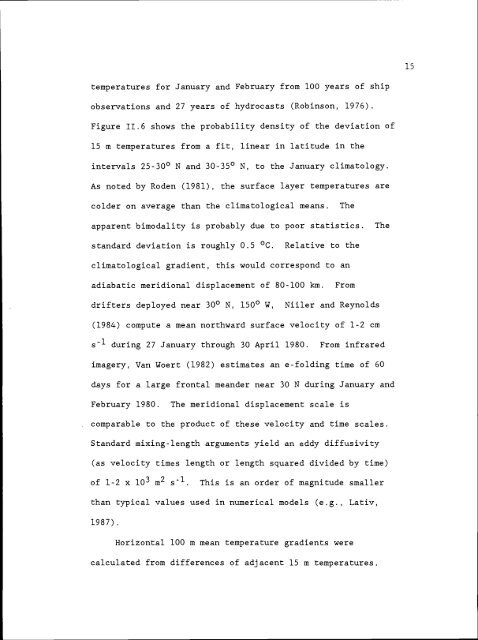Observations and Modelling of Fronts and Frontogenesis
Observations and Modelling of Fronts and Frontogenesis
Observations and Modelling of Fronts and Frontogenesis
You also want an ePaper? Increase the reach of your titles
YUMPU automatically turns print PDFs into web optimized ePapers that Google loves.
temperatures for January <strong>and</strong> February from 100 years <strong>of</strong> ship<br />
observations <strong>and</strong> 27 years <strong>of</strong> hydrocasts (Robinson, 1976).<br />
Figure 11.6 shows the probability density <strong>of</strong> the deviation <strong>of</strong><br />
15 m temperatures from a fit, linear in latitude in the<br />
intervals 253O0 N <strong>and</strong> 30-35° N, to the January climatology.<br />
As noted by Roden (1981), the surface layer temperatures are<br />
colder on average than the climatological means. The<br />
apparent bimodality is probably due to poor statistics. The<br />
st<strong>and</strong>ard deviation is roughly 0.5 °C. Relative to the<br />
climatological gradient, this would correspond to an<br />
adiabatic meridional displacement <strong>of</strong> 80-100 km. From<br />
drifters deployed near 30° N, 150° W, Niiler <strong>and</strong> Reynolds<br />
(1984) compute a mean northward surface velocity <strong>of</strong> 1-2 cm<br />
s1- during 27 January through 30 April 1980. From infrared<br />
imagery, Van Woert (1982) estimates an e-folding time <strong>of</strong> 60<br />
days for a large frontal me<strong>and</strong>er near 30 N during January <strong>and</strong><br />
February 1980. The meridional displacement scale is<br />
comparable to the product <strong>of</strong> these velocity <strong>and</strong> time scales.<br />
St<strong>and</strong>ard mixing-length arguments yield an eddy diffusivity<br />
(as velocity times length or length squared divided by time)<br />
<strong>of</strong> 1-2 x l0 m2 s1-. This is an order <strong>of</strong> magnitude smaller<br />
than typical values used in numerical models (e.g., Lativ,<br />
1987)<br />
Horizontal 100 m mean temperature gradients were<br />
calculated from differences <strong>of</strong> adjacent 15 m temperatures.<br />
15















